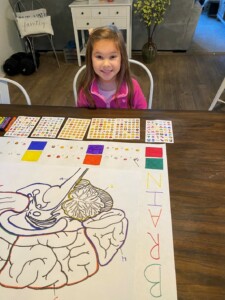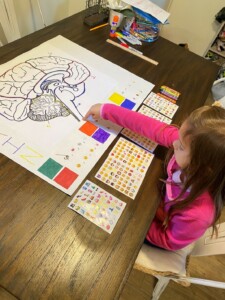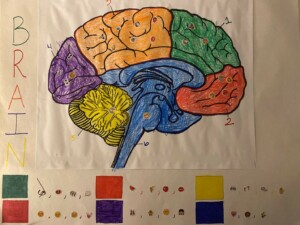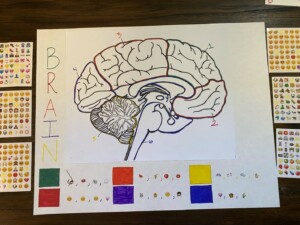It can be hard to explain dementia to anyone – especially when trying to make sense to kids. They might recognize that Grandpa doesn’t behave or communicate in the same way as their other relatives, but still have trouble understanding why. One of our wonderful interns, Lucero Hirschmugl, decided to tackle that challenge head-on.
Lucero put together a creative art project designed for children ages 4 and up – she even tested it with her own daughter! The project helped her daughter better understand interactions with her Grandfather. However, the concepts from this aren’t just for children. Dementia can be a complex topic. And in order to fully grasp it, you need to first understand what’s happening in the brain and its different functions. So whether you’re already knowledgeable about dementia and are organizing this as a fun activity for your children, or want a simple explanation to learn along with them, here’s what you need to complete this project:

- Colored pencils, markers, and/or crayons
- Stickers and stamps
- Download the blank template by clicking here >>
- Download the brain diagram by clicking here >>
The goal is to have the children identify what each part of the brain does by using the color key on the brain activity worksheet. You’ll also want to encourage them to process how each part of the brain functions. After printing the brain diagram above, prepare this activity by:
1. First, outlining each of the 6 brain sections with 6 different colors to match the color key.
2. Then, draw pictures or choose related stickers or stamps next to each color in the key that might help give the child hints about what sections are responsible for what. (For example, the temporal lobe is responsible for our sense of hearing, facial recognition, long-term memory, and emotions. If the temporal lobe section is outlined in red, include stickers of smiley faces next to the red box in the color key to help them connect the idea of emotions with the red/temporal lobe section).
3. Ask the child what they see in the color key and if they can guess from these hints what that part of the brain might do.
4. After they answer, explain what that part of the brain is called, what it does, and have them color in that section matching the corresponding colored box.
5. Once they color the brain section, ask them if they can accessorize their brain by putting more stamps, stickers, or pictures relating to the functions of that part of the brain. (For example, when they’re finished coloring the brain stem section, have them add heart stickers to emphasize that the brain stem affects your heart rate/pulse).
6. Finally, when the whole brain is colored and marked with “accessories” go over each part of the brain again describing its function.
 Then, explain to them how someone with dementia’s brain differs from that of a normal person’s. One area of the brain might be affected in the early stages for a type of dementia like Alzheimer’s disease, and eventually spread to other areas of the brain. Someone with dementia can also struggle to complete normal everyday activities, depending on what areas of their brain are affected. For instance, damage to the cerebellum which affects balance and fine motor skills might mean they have trouble with something like walking to the kitchen to retrieve and drink a cup of coffee. They also might not taste or smell their coffee because of damage to the frontal or parietal lobes.
Then, explain to them how someone with dementia’s brain differs from that of a normal person’s. One area of the brain might be affected in the early stages for a type of dementia like Alzheimer’s disease, and eventually spread to other areas of the brain. Someone with dementia can also struggle to complete normal everyday activities, depending on what areas of their brain are affected. For instance, damage to the cerebellum which affects balance and fine motor skills might mean they have trouble with something like walking to the kitchen to retrieve and drink a cup of coffee. They also might not taste or smell their coffee because of damage to the frontal or parietal lobes.
LEARN MORE | Access our tip sheets, including The Kid’s Guide to Alzheimer’s
By doing this activity, a child might better understand why certain loved ones aren’t able to do normal activities with them or hold lengthy conversations. It can be a challenge to visualize what’s happening on an internal level too. But we hope with this diagram and fun art activity, you and your child are able to learn together and bring more awareness and compassion to those living with dementia.
If you are caring for or know someone with dementia, please don’t hesitate to speak with one of our Clinical Care Coaches. They’re available for free support and expert advice at 858.492.4400.







